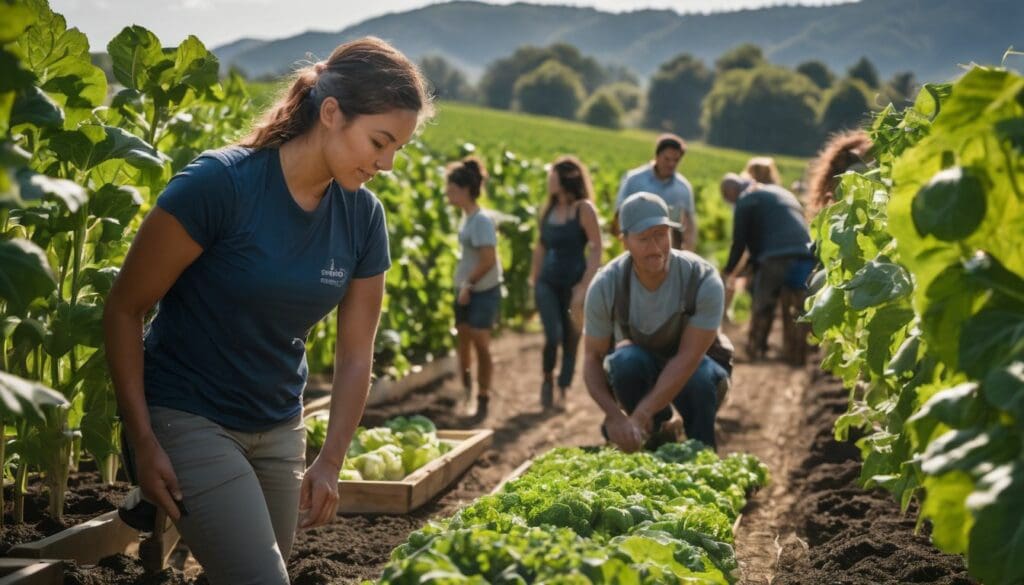Do you ever find yourself pondering whether the simple act of farming could make a significant dent in the challenges posed by climate change? You’re not alone in your worry, and rest assured, we’ve taken it upon ourselves to sift through the latest research for some clarity.
What has sprung from our journey of discovery is quite remarkable: regenerative agriculture is emerging as a beacon of hope, offering more than just plentiful yields. It whispers promises of reviving our planet’s wellbeing.
Carry on reading – there’s something quite extraordinary taking root beneath our soles.
Key Takeaways
- Regenerative agriculture locks away atmospheric carbon through soil health and biodiversity, becoming a strong ally against climate change.
- By focusing on healthy soil and diverse crops, regenerative farming practices lead to more robust and sustainable food systems resilient to droughts and extreme weather.
- Community wellbeing gets a boost from regenerative practices by reducing chemical exposure, fostering safer work environments, and improving local economies through diversified farming.
- Global scaling of regenerative agriculture faces challenges like resource allocation for farmers transitioning from traditional methods and navigating complex policy frameworks.
- Encouraging the adoption of these sustainable farming practices can contribute positively to combating climate change while offering equitable solutions in food production.
Defining Regenerative Agriculture
Regenerative agriculture aims to combat climate change, enhance food system resilience, and promote worker and community wellbeing. It focuses on restoring soil health, increasing biodiversity, and sequestering carbon in the soil.
Aims to combat climate change
We’re taking on climate change head-on with regenerative agriculture, a game-changer in the way we farm. By focusing on soil health and carbon sequestration, these innovative farming practices lock away carbon from the atmosphere, effectively acting as a natural buffer against greenhouse gases.
It’s like hitting a save point for our planet—every bit of carbon stored in the ground is one less enemy in our fight to stabilise the climate.
Our mission goes beyond just protecting what we have; it’s about healing damaged ecosystems through organic agriculture and crop rotation. We enhance biodiversity conservation while restoring balance to nature.
Imagine turning barren lands into thriving fields that can withstand extreme weather conditions—the kind of resilience climateresilient farming promises us all! With every patch of land regenerated, we contribute to ecosystem restoration and take concrete steps towards mitigating environmental impacts.
Next up: how this approach doesn’t just secure our future but also strengthens current food systems.
Enhance food system resilience
Regenerative agriculture plays a crucial role in enhancing food system resilience. By promoting healthy soil and biodiversity, regenerative farming practices contribute to the creation of robust and sustainable food systems.
The focus on improving soil health, water retention, and nutrient cycling helps to ensure the long-term productivity of agricultural land, providing greater resilience against environmental challenges such as droughts and extreme weather events.
Furthermore, regenerative agriculture enhances the nutritional quality of food by supporting diverse crop varieties that are better able to withstand changing climate conditions. This contributes to ensuring a more secure and resilient global food supply, ultimately benefiting both producers and consumers alike.
Promote worker and community wellbeing
Regenerative agriculture prioritises the health and well-being of farmers and local communities. By reducing chemical exposure, fostering healthy soil, and supporting diverse ecosystems, regenerative practices can create safer working environments for farmers while also promoting community health.
This approach offers opportunities to improve livelihoods by enhancing access to nutritious food, preserving traditional farming knowledge, and strengthening social connections within rural communities.
Furthermore, regenerative agriculture has the potential to provide economic benefits through diversified crop production and value-added products. This not only supports local economies but also contributes to greater food security in regions that depend on small-scale farming.
The Role of Self-Efficacy
Self-efficacy plays a crucial role in agricultural land management, as it impacts the successful adaptation to climate change and landscape health. Regenerative agriculture practices can enhance self-efficacy, leading to more resilient farming systems.
Importance in agricultural land management
Regenerative agriculture holds a crucial role in agricultural land management, promoting sustainable practices to enhance soil health and combat climate change. By prioritising soil regeneration, this approach improves carbon sequestration and supports biodiversity, contributing significantly to environmental significance of agriculture.
Additionally, regenerative farming techniques offer the potential for profitability in agriculture by enhancing ecosystem services and agricultural adaptation. These benefits fundamentally highlight the importance of integrating regenerative agriculture into modern farming systems.
Moreover, the environmental impact of regenerative agriculture is substantial as it focuses on restoring landscape health and preserving natural resources. Its ability to promote sustainability through efficient use of technology and agroecology is pivotal for addressing climate change mitigation challenges in agricultural land management.
As we explore its influence on successful adaptation to climate change and its significant role in building resilient food systems globally, understanding these aspects becomes paramount for implementing effective strategies.
Impact on successful adaptation to climate change
Successful adaptation to climate change is crucial in ensuring the resilience of agricultural systems. This process involves implementing proactive measures, such as regenerative agriculture practices, to mitigate the impacts of changing weather patterns on crops and livestock.
These practices not only contribute positively to soil health but also aid in carbon sequestration, which can help offset greenhouse gas emissions and combat climate change. Furthermore, regenerative agriculture promotes biodiversity and enhances ecosystem services, thus contributing to a more sustainable and resilient food system.
The potential for regenerative agriculture to play a significant role in successful adaptation to climate change is supported by emerging research findings. As farmers adopt these sustainable farming practices at scale, they could make substantial contributions towards mitigating the effects of climate change on agricultural land and improving food system resilience.
Influence on landscape health
Regenerative agriculture practices have a significant impact on landscape health. By promoting biodiversity and enhancing soil health, regenerative farming techniques contribute to the restoration of ecosystems and help combat climate change.
This holistic approach improves water and air quality, leading to healthier landscapes that benefit both wildlife and communities.
The potential of regenerative agriculture to sequester carbon is particularly noteworthy in its influence on landscape health. These practices not only enhance soil fertility but also contribute to the creation of diverse and resilient landscapes, which are crucial for sustainable food production and environmental conservation.
Enhanced by regenerative agriculture practices
Regenerative agriculture practices enhance soil health and increase biodiversity, helping to combat climate change. By improving water and air quality, this holistic farming system also promotes environmental sustainability.
The potential for regenerative agriculture to sequester carbon is of particular interest, and research is underway to compare its climate mitigation capabilities to other solutions.
The significance of regenerative agriculture in enhancing ecosystem services cannot be understated.
Latest Research on Regenerative Agriculture
The latest research on regenerative agriculture highlights the opportunities for improvement and advancement in combating climate change, enhancing food system resilience, and promoting worker and community wellbeing.
This research is crucial in understanding the potential impact of regenerative agriculture on a global scale.
Opportunities for improvement and advancement
Regenerative agriculture presents promising opportunities for improvement and advancement in combatting climate change and enhancing food system resilience. The integration of advanced agricultural technology with regenerative practices offers potential solutions for scaling sustainable agriculture on a global level, addressing challenges related to agricultural adaptation.
Research focusing on the environmental significance of agriculture is exploring the potential impact of regenerative agriculture on mitigating climate change. Moreover, efforts are being made to identify ways to promote worker and community wellbeing within the context of regenerative farming practices.
As part of our exploration into the latest research on regenerative agriculture, it’s important to highlight the significant climate mitigation potential that this approach offers.
Impact on combating climate change and enhancing food system resilience
Regenerative agriculture has a significant impact on combating climate change by capturing carbon in the soil, reducing greenhouse gas emissions, and promoting biodiversity. Through regenerative practices like cover cropping and crop rotation, this farming approach enhances soil health and resilience, mitigating the effects of extreme weather events.
The integration of agroforestry and rotational grazing not only helps combat climate change but also promotes food system resilience by improving water retention in soils, providing natural pest control, and safeguarding against erosion.
By adopting regenerative agriculture methods, farmers can contribute to global efforts to combat climate change while enhancing the resilience of our food systems. This pioneering approach offers a compelling solution for addressing both environmental challenges and ensuring sustainable food production for future generations.
Promoting worker and community wellbeing
Regenerative agriculture, with its focus on embracing a holistic approach to farming, has the potential to significantly enhance worker and community wellbeing. By prioritising sustainable practices and soil health improvement, regenerative agriculture can create healthier working environments for farmers and promote stronger connections within local communities.
As part of this movement, resources are being directed towards supporting farmers in adopting regenerative practices, ultimately fostering healthier work conditions and cultivating more resilient and interconnected communities.
The promotion of worker and community wellbeing through regenerative agriculture aligns with the broader aims of combatting climate change and enhancing food system resilience. By investing in these farming practices, we not only address environmental concerns but also strive to create more sustainable livelihoods for workers while strengthening community ties.
Scaling Regenerative Agriculture Globally
Scaling regenerative agriculture globally presents potential challenges, but building a strong baseline and setting goals for value chain improvements are crucial steps towards making a positive impact on the planet.
Potential challenges
Scaling regenerative agriculture globally comes with potential challenges, such as securing adequate resources for farmers to transition from conventional farming methods. Considering the complexity of regenerative practices, there is a need for accessible education and technical support.
Additionally, setting up strong baselines and establishing clear goals will be crucial in overcoming barriers to value chain improvements. Moreover, ensuring that regenerative agricultural practices are financially viable could also pose challenges, as initial investments may deter farmers from making the switch.
Furthermore, navigating policy frameworks and regulations to support regenerative agriculture on a global scale presents another hurdle. The diverse nature of farming systems across different regions adds layers of complexity when implementing uniform standards and incentives for regenerative practices.
Importance of building a strong baseline
To achieve widespread adoption of regenerative agriculture, it’s vital to establish a strong baseline. This involves setting clear goals for enhancing the value chain and ensuring that farmers have access to necessary resources.
Building a robust foundation is essential for scaling regenerative agriculture globally and overcoming potential challenges. With the right support and infrastructure in place, regenerative agriculture can play a pivotal role in combating climate change, improving food system resilience, and promoting worker and community wellbeing.
By establishing a solid baseline for regenerative agriculture practices, we pave the way for meaningful impact on soil health and ecosystem services. The focus is on providing farmers with the tools they need to transition towards sustainable land management practices while addressing global environmental concerns.
Setting goals for value chain improvements
- Establishing transparent and efficient supply chains to ensure fair wages for workers and support community development.
- Implementing regenerative farming practices across the entire value chain to minimise environmental impact and maximise biodiversity.
- Encouraging collaboration between farmers, distributors, and consumers to enhance traceability and accountability in the food production process.
- Investing in research and development to innovate new technologies and techniques that promote regenerative agriculture on a global scale.
Conclusion: The Future of Farming
The future of farming lies in regenerative agriculture, as it has the potential to revolutionise our food and land systems for a more sustainable and equitable future. If you want to learn more about how regenerative agriculture can save the planet, keep reading!
Role of regenerative agriculture in sustainable and equitable food and land systems
Regenerative agriculture plays a crucial role in creating sustainable and fair food and land systems. It contributes to restoring biodiversity, combatting climate change, and enhancing soil health.
This farming approach promotes worker and community well-being while aiming to feed the world’s growing population. Through regenerative agriculture, we have the opportunity to improve water and air quality, maximise ecosystem services, and mitigate climate change by sequestering carbon.
Furthermore, this holistic farming system enhances landscape health and resilience, making it an essential component for building a sustainable future.
Encouraging regenerative food practices
Encouraging regenerative food practices is vital in the quest for sustainable and equitable food systems. By supporting regenerative agriculture, we can actively contribute to restoring biodiversity, fighting climate change and enhancing soil health.
This farming approach goes beyond simply sustainable or organic methods, aiming to rebuild soils and mitigate climate change. The potential of regenerative agriculture to sequester carbon and improve water and air quality makes it a promising solution with significant climate mitigation potential.
As passionate gamers or novice players interested in making a positive impact on the planet through simple daily choices, embracing regenerative food practices can be a tangible way to support environmental sustainability while ensuring access to nutritious foods for future generations.
The decade for making a positive impact on the planet.
Regenerative agriculture is at the forefront of combating climate change and enhancing food system resilience. This decade presents a crucial opportunity to scale regenerative practices globally and make a profound impact on the planet.
With its potential to restore biodiversity, fight the climate crisis, and improve soil health, regenerative agriculture offers promising solutions for sustainable and equitable food and land systems.
As passionate gamers or novice gamers interested in making a positive impact, embracing regenerative food practices can contribute significantly to the wellbeing of communities and workers while addressing critical environmental challenges.
FAQs
1. What is regenerative agriculture?
Regenerative agriculture involves farming practices that restore the health of the soil and help in the fight against climate change.
2. Can this type of farming really save our planet?
The latest research suggests that by improving biodiversity and reducing carbon emissions, regenerative agriculture may play a key role in preserving the environment for future generations.
3. How does regenerative agriculture impact climate change?
Farming methods used in regenerative agriculture can capture carbon from the atmosphere, which helps to lower greenhouse gasses and potentially lessen global warming effects.
4. Are scientists optimistic about regenerative agricultural practices?
Yes, recent studies are hopeful because these sustainable practices have shown promise in replenishing soil health and contributing to environmental sustainability.





